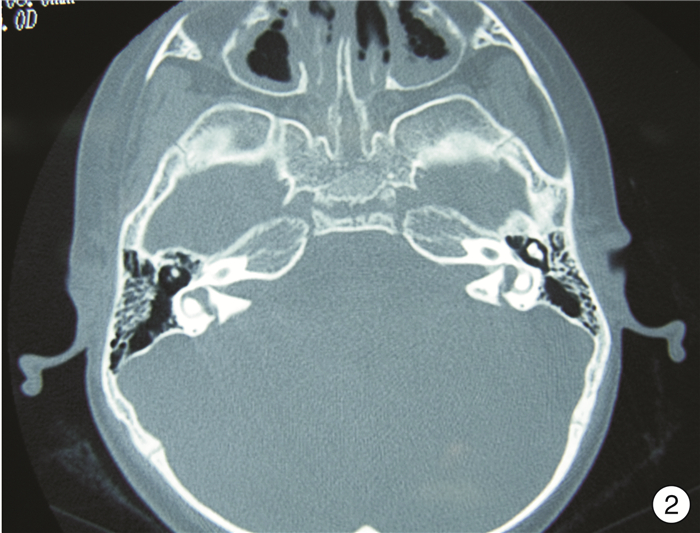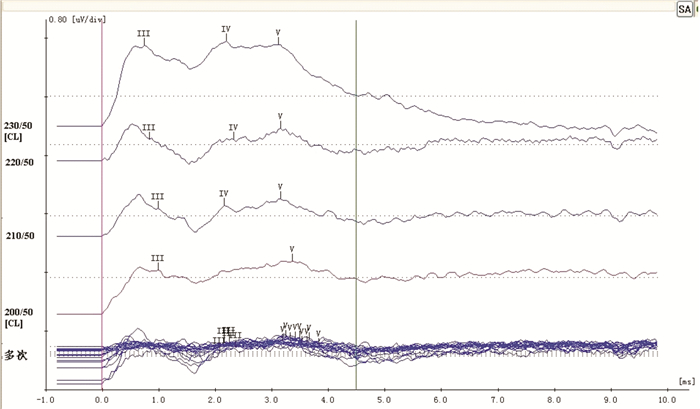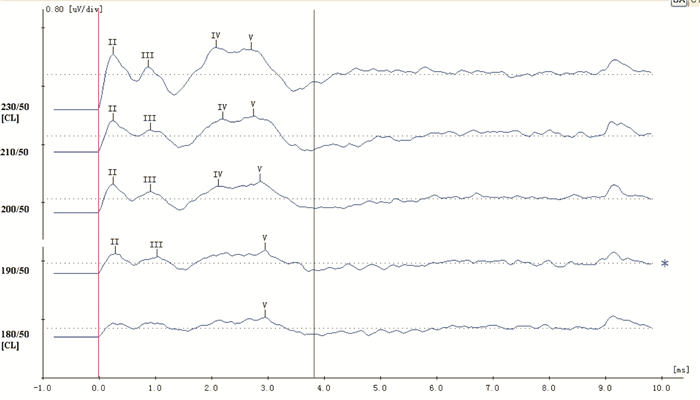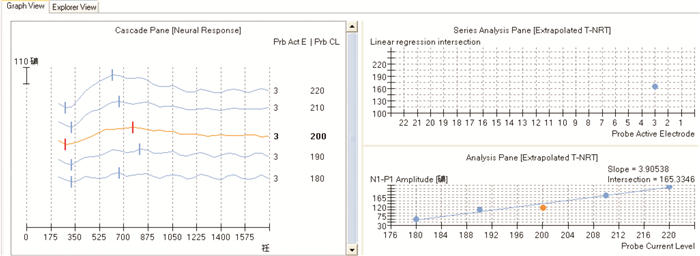Analysis of intraoperative EABR characteristics and postoperative efficacy of cochlear implant in patients with tinnitus
-
摘要: 目的 探讨伴耳鸣耳聋患者术中电刺激听觉脑干诱发电位(EABR)的特点,分析人工耳蜗植入术(CI)对耳鸣的抑制效果及与听觉诱发电位相关性。方法 选择2014—2015年行CI的成人神经性聋伴耳鸣患者28例(耳鸣组),另选择相同耳聋时间的不伴耳鸣患者10例(对照组),回顾性分析两组患者术前听力学、影像学及耳鸣病史等资料,术中采用EABR检测各级听觉中枢功能,分析其电生理特点; 术后随访开机调试结果,采用耳鸣残疾评估量表(THI)评估患者术前和术后耳鸣变化情况,将EABR结果和THI评分进行相关性分析。结果 38例患者术中电极全部植入耳蜗内,术后无面瘫、脑脊液漏、脑膜炎等手术并发症,术后均获得不同程度的电听性反应; 术中EABR结果经最小显著性t检验:Ⅲ波波幅、Ⅴ波波幅及Ⅴ波潜伏期在耳鸣组与对照组的差异有统计学意义(P < 0.05);耳鸣组Ⅲ波波幅大于Ⅴ波波幅(P < 0.05);两组患者开机12个月调机平均C值(162.78±24.57) CL和术中EABR平均阈值(158.62±10.31) CL,经直线相关分析呈明显相关(r=0.903,P < 0.01);28例耳鸣患者CI术前、术后1 d、术后1年三个时间点THI总分分别为65.00±14.93,55.00±15.93,36.00±21.02,经方差分析术后1年得分差异有统计学意义(P < 0.05),术后1 d较术前差异无统计学意义(P>0.05);术中EABR波形Ⅲ波波幅和术后1年THI变化直线相关分析有显著相关性(r=0.873,P < 0.05)。结论 伴耳鸣的耳聋患者术中EABR与不伴耳鸣患者有明显差异,人工耳蜗电刺激对神经性耳鸣有较好的抑制作用,术中EABR为研究人工耳蜗抑制耳鸣提供了一种客观的评估方法。
-
关键词:
- 耳鸣 /
- 耳蜗植入术 /
- 电刺激听觉脑干诱发电位
Abstract: Objective To investigate the characteristics of intraoperative electrically stimulated auditory brainstem responses(EABR) in patients with neural deafness and tinnitus, and to analyze the inhibitory effect of cochlear implantation on tinnitus and its correlation with auditory evoked potential.Methods Twenty-eight adult patients with neuronal deafness accompanied by tinnitus who underwent cochlear implant surgery in the Peking Union Medical College Hospital from 2014 to 2015 were selected, and 10 age-matched patients without tinnitus with the same age were selected as the control group. Preoperative audiology, imaging and tinnitus history of the patients were retrospectively analyzed. During the operation, EABR were used to detect the auditory central functions at all levels, and the electrophysiological characteristics of the two groups were analyzed. The tinnitus handicap inventory(THI) was used to evaluate the severity of tinnitus before and after surgery, and the correlation between EABR results and THI score was analyzed.Results There were no postoperative complications such as facial paralysis, cerebrospinal fluid leakage, meningitis, etc., and electroacoustic reactions were observed in all 38 patients. The results of intraoperative EABR showed that there were significant differences in Ⅲ wave amplitude, Ⅴ wave amplitude and Ⅴ wave latency between tinnitus group and control group(P < 0.05). The mean C value of (162.78± 24.57)CL and the mean intraoperative EABR threshold of (158.62± 10.31) CL were collected in the two groups 12 months after starting the machine, and there was a significant correlation according to linear correlation analysis(r=0.903, P < 0.01). The total THI scores of 28 tinnitus patients were 65.00±14.93, 55.00±15.93 and 36.00±21.02 at three time points before, 1 day after and 1 year after cochlear implantation, respectively. The scores of 1 year after cochlear implantation were significantly different by ANOVA(P < 0.05), but there was no statistically significant difference 1 day after operation(P>0.05). There was significant correlation between the intraoperative EABR wave Ⅲ amplitude and the linear correlation analysis of THI changes 1 year after operation(r=0.873, P < 0.05).Conclusion There is significant difference in intraoperative EABR between patients with neural deafness accompanied with tinnitus and patients without tinnitus. Cochlear electrical stimulation has a good inhibitory effect on tinnitus, and intraoperative EABR can be used as a objective assessment tool for cochlear implant to inhibit tinnitus. -

-
表 1 耳鸣组患者信息一览表(n=28)
例序 性别 年龄 耳聋原因 耳聋时间 耳鸣时间 植入耳 型号 1 女 56 突发性聋 7年 7年 左 CA 2 男 26 不明原因 13年 13年 右 CA 3 男 17 LVAS 11年 11年 右 CA 4 男 28 不明原因 20年 5年 左 CI422 5 男 54 神经性聋 5年 5年 右 F-CA 6 男 39 头外伤 1.5年 1.5年 左 F-CA 7 男 45 神经性聋 9年 9年 右 CA 8 女 62 神经性聋 8年 8年 右 CA 9 男 45 突发性聋 7个月 7个月 右 ST 10 男 64 突发性聋 6个月 6个月 左 ST 11 男 20 LVAS 8年 5年 右 512 12 男 47 神经性聋 18年 18年 右 F-CA 13 男 39 突发性聋 5个月 5个月 右 CA 14 男 27 不明原因 双侧10年 双侧10年 双 CA 15 男 43 神经性聋 6年 6年 右 F-ST 16 女 21 LVAS 1年 1年 右 422 17 女 50 突发性聋 6个月 20年 左 F-ST 18 女 29 不明原因 13年 20年 左 512 19 男 26 不明原因 9年 14年 右 CS-10A 20 女 28 突发性聋 6个月 10年 右 F-ST 21 女 28 LVAS 16年 16年 左 F-CA 22 男 25 LVAS 12年 12年 右 422 23 男 47 中耳炎 35年 35年 左 422 24 男 23 LVAS 5个月 9年 右 F-CA 25 女 69 神经性聋 8年 8年 左 F-ST 26 男 20 LVAS 2年 2年 左 512 27 男 45 神经性聋 1年 4年 左 512 28 男 29 不明原因 20年 20年 右 F-CA 表 2 两组患者术中EABR检测Ⅲ波、Ⅴ波参数
组别 例数 Ⅲ波波幅 Ⅴ波波幅 Ⅴ波潜伏期 耳鸣组 28 0.42±0.131)2) 0.33±0.101) 4.85±0.541) 对照组 10 0.25±0.03 0.55±0.07 4.04±0.32 与对照组比较,1)P < 0.05;与Ⅴ波波幅比较,2)P < 0.05。 -
[1] Savage J, Waddell A. Tinnitus[J]. Am Fam Physician, 2014, 89(6): 471-472.
[2] 王斌, 曹克利, 魏朝刚. 听神经病人工耳蜗植入术中EABR监测及其疗效评估[J]. 临床耳鼻咽喉头颈外科杂志, 2013, 27(10): 449-454. https://www.cnki.com.cn/Article/CJFDTOTAL-LCEH201310002.htm
[3] 石秋兰, 卜行宽, 王俊国, 等. 耳鸣致残量表中文版的研译与临床应用[J]. 南京医科大学学报: 自然科学版, 2007, 27(5): 476-479. doi: 10.3969/j.issn.1007-4368.2007.05.018
[4] Gibson WP, Sanli H, Psarros C. The use of intra-operative electrical auditory brainstem responses to predict the speech perception outcome after cochlear implantation[J]. Cochlear Implants Int, 2009, 10 Suppl 1: 53-57.
[5] Domarecka E, Olze H, Szczepek AJ. Auditory Brainstem Responses(ABR)of Rats during Experimentally Induced Tinnitus: Literature Review[J]. Brain Sci, 2020, 10(12): 901. doi: 10.3390/brainsci10120901
[6] 吴文丽, 丁雷, 高铭媛, 等. 单侧急性耳鸣患者耳蜗电生理学研究[J]. 临床耳鼻咽喉头颈外科杂志, 2022, 36(5): 357-361. https://www.cnki.com.cn/Article/CJFDTOTAL-LCEH202205007.htm
[7] 杨旭春, 方耀云. 不同年龄组大鼠听性脑干反应结果分析[J]. 听力学及言语疾病杂志, 2004, 12(1): 28-34. doi: 10.3969/j.issn.1006-7299.2004.01.012
[8] 范欣, 宋昱, 马芙蓉. 浅谈扣带回生理功能及其在耳鸣发生中的作用[J]. 临床耳鼻咽喉头颈外科杂志, 2020, 34(12): 1141-1144. https://www.cnki.com.cn/Article/CJFDTOTAL-LCEH202012023.htm
[9] Henry MA, Freking AR, Johnson LR, et al. Increased sodium channel immunofluorescence at myelinated and demyelinated sites following an inflammatory and partial axotomy lesion of the rat infraorbital nerve[J]. Pain, 2006, 124(1/2): 222-233.
[10] 龚树生, 陈成芳. 人工耳蜗植入与耳鸣[J]. 中国医学文摘(耳鼻咽喉科学), 2009, 24(5): 244-246. https://www.cnki.com.cn/Article/CJFDTOTAL-ZYEB200905009.htm
[11] van Zwieten G, Jahanshahi A, van Erp ML, et al. Alleviation of Tinnitus With High-Frequency Stimulation of the Dorsal Cochlear Nucleus: A Rodent Study[J]. Trends Hear, 2019, 23: 1-10.
[12] Bovo R, Ciorba A, Martini A. Tinnitus and cochlear implants[J]. Auris Nasus Larynx, 2011, 38(1): 14-20. doi: 10.1016/j.anl.2010.05.003
[13] 李树华. 水杨酸钠的耳毒性机理研究进展[J]. 听力学及言语疾病杂志, 2001, 9(3): 174-176. doi: 10.3969/j.issn.1006-7299.2001.03.026
[14] Di Nardo W, Cantore I, Cianfrone F, et al. Tinnitus modifications after cochlear implantation[J]. Eur Arch Otorhinolaryngol, 2007, 264(10): 1145-1149. doi: 10.1007/s00405-007-0352-7
[15] Zeng FG, Djalilian H, Lin H. Tinnitus treatment with precise and optimal electric stimulation: opportunities and challenges[J]. Curr Opin Otolaryngol Head Neck Surg, 2015, 23(5): 382-387. doi: 10.1097/MOO.0000000000000187
-




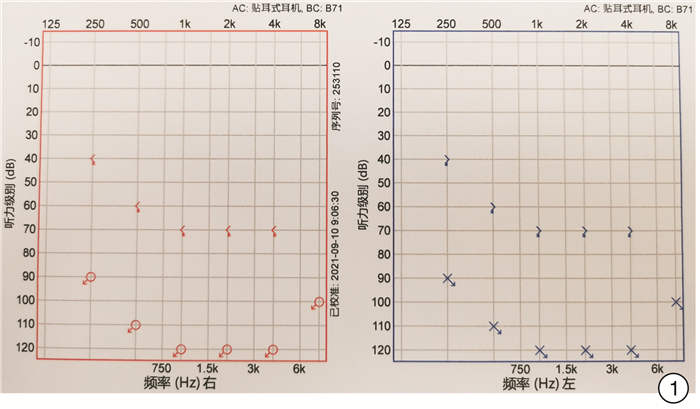
 下载:
下载:
